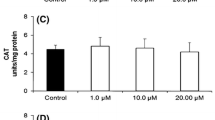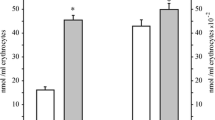Abstract
In the present study, we investigated, in vivo (acute and chronic) and in vitro, the effects of proline on the activities of antioxidant enzymes such as catalase (CAT), glutathione peroxidase and superoxide dismutase (SOD) in erythrocytes and also investigated the effect on thiobarbituric acid-reactive substances (TBARS) in the plasma of rats. For the experiments, the number of animals per group ranged from eight to ten. For acute administration, 29-day-old rats received one subcutaneous injection of proline (18.2 μmol/g body weight) or an equivalent volume of 0.9% saline solution (control) and were killed 1 h later. For chronic treatment, buffered proline was injected subcutaneously into rats twice a day at 10 h intervals from the 6th to the 28th day of age. Rats were killed 12 h after the last injection. For in vitro studies, proline (30.0 μM to 1.0 mM) was added to the incubation medium. Results showed that acute administration of proline reduced CAT and increased SOD activities, while chronic treatment increased the activities of CAT and SOD in erythrocytes and TBARS in the plasma of rats. Furthermore, in vitro studies showed that proline increased TBARS in the plasma (0.5 and 1.0 mM) and CAT activity (1.0 mM) in the erythrocytes of rats. The influence of the antioxidants (α-tocopherol plus ascorbic acid) on the effects elicited by proline was also studied. Treatment with antioxidants for 1 week or from the 6th to the 28th day of age prevented the alterations caused by acute and chronic, respectively, proline administration on the oxidative parameters evaluated. Data indicate that proline alters antioxidant defenses and induces lipid peroxidation in the blood of rats.







Similar content being viewed by others
References
Phang JM, Hu CA, Valle D (2001) Disorders of proline and hydroxyproline metabolism. In: Scriver CR, Beaudet AL, Sly WS, Valle D (eds) The metabolic and molecular bases of inherited disease, 8th edn. McGraw-Hill, New York, pp 1821–1838
Moreira JCF, Wannmacher CMD, Costa SM, Wajner M (1989) Effect of proline administration on rat behavior in aversive and nonaversive tasks. Pharmac Biochem & Behav 32:885–890
Delwing D, Bavaresco CS, Chiarani F, Wannmacher CMD, Wajner M, Dutra-Filho CS, Wyse ATS (2003) In vivo and in vitro effects of proline on some parameters of oxidative stress in rat brain. Brain Res 991:180–186
Delwing D, Bavaresco CS, Wannmacher CMD, Wajner M, Dutra-Filho CS, Wyse ATS (2003) Proline induces oxidative stress in cerebral cortex of rats. Int J Dev Neurosci 21:105–110
Delwing D, Chiarani F, Wannmacher CMD, Wajner M, Wyse ATS (2005) Effect of hyperprolinemia on acetylcholinesterase and butyrylcholinesterase activities in rat. Amino acids 28:305–308
Delwing D, Delwing D, Sarkis JJ, Wyse ATS (2006) Proline induces alterations in nucleotide hydrolysis in rat blood serum. Mol Cell Biochem 292:139–144
Commoner B, Townsend J, Pake G (1954) Free radicals in biological materials. Nature 174:689–691
Gutteridge JM, Halliwell B (2000) Free radicals, antioxidants in the year 2000. A historical look to the future. Ann NY Acad Sci 899:136–147
Fubini B, Hubbard A (2003) Reactive oxygen species (ROS) and reactive nitrogen species (RNS) generation by silica in inflammation and fibrosis. Free Radic Biol Med 34:1507–1516
Ross D, Moldeus P (1991) Antioxidant defense systems and oxidative stress. In: Vigo-Pelfrey C (ed) Membrane lipid oxidation. CRC, Boca Raton, pp 151–170
Fang YZ (2002) Free radicals and nutrition. In: Fang YZ, Zheng RL (eds) Theory and application of free radical biology. Scientific Press, Beijing, p 647
Andreyev AY, Kushnareva YE, Starkov AA (2005) Mitochondrial metabolism of reactive oxygen species. Biochemistry (Mosc) 70:200–214
Wyse ATS, Zugno AI, Streck EL, Matte C, Calcagnotto T, Wannmacher CMD, Wajner M (2002) Inhibition of Na+, K + -ATPase activity in hippocampus of rats subjected to acute administration of homocysteine is prevented by vitamins E and C treatment. Neurochem Res 27:1685–1689
Aebi H (1984) Catalase in vitro. Methods Enzymol 105:121–126
Wendel A (1981) Glutathione peroxidase. Method Enzymol 77:325–332
Marklund SL (1985) Pyrogallol autoxidation. In: Greenwald RA (ed) Handbook for oxygen radical research. CRC, Boca Raton, pp 243–247
Ohkawa H, Ohishi N, Yagi K (1979) Assay for lipid peroxides in animal tissues by thiobarbituric acid reaction. Anal Biochem 95:351–358
Lowry OH, Rosebrough NJ, Farr AL, Randall RJ (1951) Protein measurement with the folin phenol reagent. J Biol Chem 193:265–267
Halliwell B (2006) Oxidative stress and neurodegeneration: where are we now? J Neurochem 97:1634–1658
Halliwell B, Whiteman M (2004) Measuring reactive species and oxidative damage in vivo and in cell culture: How should you do it and what do the results mean? Br J Pharmacol 142:231–255
Travacio M, Llesuy S (1996) Antioxidant enzymes and their modification under oxidative stress conditions. Free Radic Res Latin Am 48:9–13
Wyse ATS, Streck EL, Worm P, Wajner A, Ritter F, Netto CA (2000) Preconditioning prevents the inhibition of Na+, K + −ATPase activity after brain ischemia. Neurochem Res 25:971–975
Halliwell B, Gutteridge JMC (1999) Oxidative stress: adaptation, damage, repair and death. In: Free radicals in biology and medicine, 3rd ed. Oxford University Press, Oxford, pp 246–349
Traber MG, Atkinson J (2007) Vitamin E, antioxidant and nothing more. Free Radic Biol Med 43:4–15
Nazıroğlu MM (2007) Molecular mechanisms of vitamin E on intracellular signaling pathways in brain. In: Goth L (ed) Reactive oxygen species and diseases. Research Signpost Press, Kerala, pp 239–256
Ceylan BG, Nazıroğlu MM, Uğuz AC, Barak C, Erdem B, Yavuz L (2011) Effects of desflurane and vitamin C and E combination on element and oxidative stress levels in blood of operative patients. Biol Trace Elem Res 141:16–25
Nazıroğlu MM, Butterworth PJ (2005) Protective effects of moderate exercise with dietary vitamin C and E on blood antioxidative defense mechanism in rats with streptozotocin-induced diabetes. Can J Appl Physiol 30:172–185
Sirmali M, Uz E, Sirmali R, Kilbaş A, Yilmaz HR, Altuntaş I, Naziroğlu M, Delibaş N, Vural H (2007) Protective effects of erdosteine and vitamins C and E combination on ischemia-reperfusion-induced lung oxidative stress and plasma copper and zinc levels in a rat hind limb model. Biol Trace Elem Res 118:43–52
Acknowledgments
This work was supported by grants from Universidade Regional de Blumenau and PIBIC/CNPq (Conselho Nacional de Desenvolvimento Científico e Tecnológico).
Author information
Authors and Affiliations
Corresponding author
Rights and permissions
About this article
Cite this article
Roecker, R., Junges, G.M., de Lima, D.D. et al. Proline Alters Antioxidant Enzyme Defenses and Lipoperoxidation in the Erythrocytes and Plasma of Rats: In Vitro and In Vivo Studies. Biol Trace Elem Res 147, 172–179 (2012). https://doi.org/10.1007/s12011-011-9276-6
Received:
Accepted:
Published:
Issue Date:
DOI: https://doi.org/10.1007/s12011-011-9276-6




